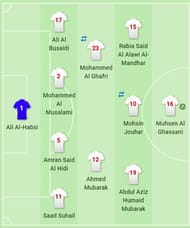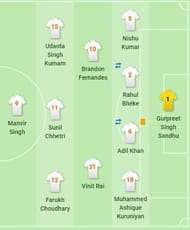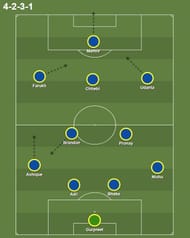India's push to the next round of qualification for the 2022 World Cup was dealt a blow in the very first game -- the Blue Tigers lost a home fixture in September against Oman in Guwahati. Back-to-back draws to Bangladesh and Afghanistan pushed India down. And a poor performance against Oman, a loss in Muscat, completed the cycle of dismay and disappointment for a nation of 1.3 billion.
Fans had a little hope in Indian football when India thumped Thailand 4-1 in the 2019 AFC Asian Cup when few expected them to do so. The Blue Tigers' successive losses to UAE and Bahrain to bow out of the competition was considered unfortunate. Fans believed there could be new dawn if Stephen Constantine was relieved of his duties and a coach with international experience and exposure was handed over the reins.
Indian football fanatics held their horses for four long months to hear the news that Igor Štimac has been awarded the job and the fans started looking to the ex-Croatia manager, who had the likes of Luka Modrić under his care, eyes wide open. Since then, in eight games, victory has eluded Štimac.
Without further ado, let's dive into the tactical aspect of Oman vs India and the reasons India could not salvage a point away from home.
Lineups
Erwin Koeman tweaked his formation from the last game against India and started the game with a 4-2-3-1 formation. He made numerous changes to his starting lineup from the game Oman played in Guwahati. The former Premier League goalkeeper Ali Al-Habsi slotted between the sticks. Saad A Mukhani and Ali Sulaiman Al-Busadi assumed their usual positions on either side of Mohammed al Musallami and Amran Said Al Hidi in defence.

Ahmed Kano and Harib Al Saadi provided the extra layer of protection in the midfield and Rabia Al Mandhar and Mohammed al-Ghafri were the wingers who often drifted narrow to create space for the overlapping full-backs. Mohsin al Khadi occupied the position just behind the striker Muhsen Al Ghassani.
Štimac came out with a different formation from the very start. The Croat opted to trust in his tried and tested formation 4-2-3-1, with Sunil Chhetri just behind Manvir Singh. Udanata Singh and Farukh Chaudhary were trusted to deliver crosses inside the Oman box from the wings. Brandon Fernandes and Pronay Halder were stationed in the heart of the midfield.

Štimac tweaked his backline and Ashique Kuruniyan was slotted in the left-back position from the very start. The centre-back pair of Rahul Bheke and Adil Khan started the second game in a row in the heart of the defence. Nishu Kumar was handed the senior team debut and he manned the right-back position.
Oman's flexibility
Oman started with a similar formation to India but kept on changing their formations throughout the game during transitions and build-up play.
Indian forwards marked the double pivot of Kano and Al Saadi during Oman's buildup. Kano was constantly marked by Manvir and Chhetri kept tabs on Al Saadi. It left Oman with few passing options to buildup their play. To open up more passing lanes for the centre-backs, Kano often dropped deep to form a three-man backline.
However, Oman were flexible in their approach as they often drifted from their three-man backline to a two-man initial setup, sensing the situation of the game. It confused the FC Goa striker. He was unable to decide whether to move up to press Kano or maintain the shape.
On occasions even the no. 10, Al Khaldi dropped deep to receive the passes in his own half and produce defence splitting passes with hardly any pressure from the opposition. When the midfielders dropped deep, the full-backs pushed forward almost acting as a winger. The veteran Al Mukhaini often found himself in the final third creating chances for his team. He often troubled the Blue Tigers with his pace, bursting forward.
Brandon at left-back
Štimac also made slight adjustments to the Indian setup when they were in possession. India started with 4-2-3-1, with Brandon and Pronay acting as the double pivot. The former was utilised in a more deeper role in the last game against Afghanistan due to his ability to play long and diagonal balls. The Croatian went one step further to slot him at the left-back position during India's buildup.
When India were in possession, The ex-Croatia manager instructed Ashique to push forward and the vacant position was occupied by the FC Goa stalwart.

It created a 4-1-4-1 formation. Brandon, Adil, Bheke and Nishu were the defenders of the modified setup. Pronay acted as the only pivot. Farukh moved narrow to create space for Ashique to make his overlapping runs and deliver crosses into the box which he is his forte. This resulted in few chances for the Blue Tigers.
Štimac's intention was vivid from the very beginning. He wanted Brandon to have enough time to play accurate long balls to the final third and trouble the opposition as the Reds did not press aggressively. The long ball approach failed miserably. The Oman defenders were superior in the air and stood true to their task.
However, in the latter stages of the second-half, Brandon did not drop deep to occupy the left-back position and maintained the position in which he is known for.
Štimac's left-back conundrum
The Croatian continued with Subhasish Bose in his early days, but his continuous poor performances in the National colours as well as with his club, Mumbai FC, instigated Štimac to look elsewhere.
Štimac experimented with the makeshift left-back Mandar who produced a brilliant performance to keep the Qatari attacks at bay. The performance against Qatar amalgamated with his rich vein of form for his club made him a first-choice left-back for few games. However, his horrendous show in the last game against Afghanistan put in motion another shuffling at the left-back position.
Ashique Kuruniyan who had played all the four games for Bengaluru FC in the left-back position was given a chance. Ashique's height helps him dominate in the air against his opponents. He is also a quality one on one defender. Whenever he has been slotted in the left-back position he has won 66.7% of the defensive duels and 50% of the aerial duels compared to Mandar's 61.2% success rate in defensive duels and 27.8% in aerial duels.
However, the problem with Ashique's game is that he loses the ball too often and the number is staggering, to say the least. He looses 11.38 balls per90 minutes, with 24.7% of times in his own half. Oman initiated few attacks through Ashique's mistimed clearances and his inability to hold the ball in crunch situations cost India dearly.
The other problem to his game is that he occasionally loses his man and fails to maintain a compact defensive shape. India conceded seven goals from through balls in Štimac's era and Oman scored the eighth. Al Khaldi slid in a delicious through ball for the Oman striker, Al Ghassani and the striker lost his marker who happened to be Ashique, to put the home side ahead.